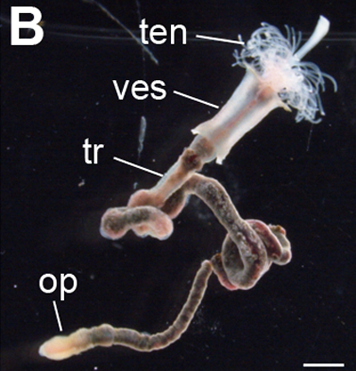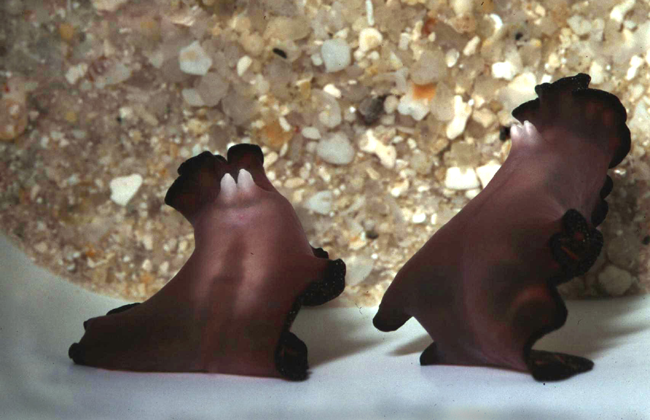|
Marine Worms
Any worm that lives in a marine environment is considered a marine worm. Marine worms are found in several different phyla, including the Platyhelminthes, Nematoda, Annelida (segmented worms), Chaetognatha, Hemichordata, and Phoronida. For a list of marine animals that have been called "sea worms", see sea worm. Reproduction Marine worms exhibit numerous types of reproduction, both sexually and asexually. Asexually many are able to reproduce via budding or regeneration. This regeneration is most notably studied in Plathelminths or Triclad, known for being one of the earliest animals to be studied for its regenerative capabilities. Marine worms will also sexually reproduce, internally and externally, with some releasing spawn into the ocean currents. This is in opposition to the much more internal and invasive method displayed by flat-worms called Penis fencing where hermaphroditic organisms will flight to try and impregnate their opponent while avoiding becoming impregnated. ... [...More Info...] [...Related Items...] OR: [Wikipedia] [Google] [Baidu] |
Proboscis Worm
Nemertea is a phylum of animals also known as ribbon worms or proboscis worms, consisting of 1300 known species. Most ribbon worms are very slim, usually only a few millimeters wide, although a few have relatively short but wide bodies. Many have patterns of yellow, orange, red and green coloration. The foregut, stomach and intestine run a little below the midline of the body, the anus is at the tip of the tail, and the mouth is under the front. A little above the gut is the rhynchocoel, a cavity which mostly runs above the midline and ends a little short of the rear of the body. All species have a proboscis which lies in the rhynchocoel when inactive but everts to emerge just above the mouth to capture the animal's prey with venom. A highly extensible muscle in the back of the rhynchocoel pulls the proboscis in when an attack ends. A few species with stubby bodies filter feed and have suckers at the front and back ends, with which they attach to a host. The brain is a rin ... [...More Info...] [...Related Items...] OR: [Wikipedia] [Google] [Baidu] |
Sea Worm (other)
Sea worm may refer to one or several of the following phyla: See also * Marine worm Any worm that lives in a marine environment is considered a marine worm. Marine worms are found in several different phyla, including the Platyhelminthes, Nematoda, Annelida (segmented worms), Chaetognatha, Hemichordata, and Phoronida. For a ... {{Animal common name Marine animals ... [...More Info...] [...Related Items...] OR: [Wikipedia] [Google] [Baidu] |
Galápagos Islands
The Galápagos Islands ( Spanish: , , ) are an archipelago of volcanic islands. They are distributed on each side of the equator in the Pacific Ocean, surrounding the centre of the Western Hemisphere, and are part of the Republic of Ecuador. Located west of continental Ecuador, the islands are known for their large number of endemic species that were studied by Charles Darwin during the second voyage of HMS ''Beagle''. His observations and collections contributed to the inception of Darwin's theory of evolution by means of natural selection. The Galápagos Islands and their surrounding waters form the Galápagos Province of Ecuador, the Galápagos National Park, and the Galápagos Marine Reserve. The principal language on the islands is Spanish. The islands have a population of slightly over 25,000. The first recorded visit to the islands happened by chance in 1535, when Fray Tomás de Berlanga, the Bishop of Panamá, was surprised to find this undiscovered land ... [...More Info...] [...Related Items...] OR: [Wikipedia] [Google] [Baidu] |
Oceanic Trench
Oceanic trenches are prominent long, narrow topographic depressions of the ocean floor. They are typically wide and below the level of the surrounding oceanic floor, but can be thousands of kilometers in length. There are about of oceanic trenches worldwide, mostly around the Pacific Ocean, but also in the eastern Indian Ocean and a few other locations. The greatest ocean depth measured is in the Challenger Deep of the Mariana Trench, at a depth of below sea level. Oceanic trenches are a feature of the Earth's distinctive plate tectonics. They mark the locations of convergent plate boundaries, along which lithospheric plates move towards each other at rates that vary from a few millimeters to over ten centimeters per year. Oceanic lithosphere moves into trenches at a global rate of about 3 km2/yr. A trench marks the position at which the flexed, subducting slab begins to descend beneath another lithospheric slab. Trenches are generally parallel to and about from ... [...More Info...] [...Related Items...] OR: [Wikipedia] [Google] [Baidu] |
Volcanoes
A volcano is a rupture in the crust of a planetary-mass object, such as Earth, that allows hot lava, volcanic ash, and gases to escape from a magma chamber below the surface. On Earth, volcanoes are most often found where tectonic plates are diverging or converging, and most are found underwater. For example, a mid-ocean ridge, such as the Mid-Atlantic Ridge, has volcanoes caused by divergent tectonic plates whereas the Pacific Ring of Fire has volcanoes caused by convergent tectonic plates. Volcanoes can also form where there is stretching and thinning of the crust's plates, such as in the East African Rift and the Wells Gray-Clearwater volcanic field and Rio Grande rift in North America. Volcanism away from plate boundaries has been postulated to arise from upwelling diapirs from the core–mantle boundary, deep in the Earth. This results in hotspot volcanism, of which the Hawaiian hotspot is an example. Volcanoes are usually not created where two tectonic plates ... [...More Info...] [...Related Items...] OR: [Wikipedia] [Google] [Baidu] |
Giant Tube Worm
''Riftia pachyptila'', commonly known as the giant tube worm and less commonly known as the Giant beardworm, is a marine invertebrate in the phylum Annelida (formerly grouped in phylum Pogonophora and Vestimentifera) related to tube worms commonly found in the intertidal and pelagic zones. ''R. pachyptila'' lives on the floor of the Pacific Ocean near hydrothermal vents, the vents provide a natural ambient temperature in their environment ranging from 2 to 30 °C, at the same time it can tolerate extremely high hydrogen sulfide levels. These worms can reach a length of , and their tubular bodies have a diameter of . Its common name "giant tube worm" is, however, also applied to the largest living species of shipworm, '' Kuphus polythalamius'', which despite the name "worm", is a bivalve mollusc rather than an annelid. Discovery ''R. pachyptila'' was discovered in 1977 on an expedition of the American bathyscaphe DSV ''Alvin'' to the Galápagos Rift led ... [...More Info...] [...Related Items...] OR: [Wikipedia] [Google] [Baidu] |
Tube Worm (body Plan)
A tubeworm is any worm-like sessile invertebrate that anchors its tail to an underwater surface and secretes around its body a mineral tube, into which it can withdraw its entire body. Tubeworms are found among the following taxa: * Annelida, the phylum containing segmented worms ** Polychaetea, the class containing bristle worms *** Canalipalpata, the order containing bristle-footed annelids or fan-head worms **** Siboglinidae, the family of beard worms ***** ''Riftia pachyptila'', a species known as giant tube worms ***** Lamellibrachia, a genus **** Serpulidae The Serpulidae are a family of sessile, tube-building annelid worms in the class Polychaeta. The members of this family differ from other sabellid tube worms in that they have a specialized operculum that blocks the entrance of their tubes wh ..., a family **** Sabellidae, the family containing feather duster worms * Phoronida, the phylum containing horseshoe worms * Microconchida, an order of extinct tubeworms ... [...More Info...] [...Related Items...] OR: [Wikipedia] [Google] [Baidu] |
Trophosome
A trophosome is a highly vascularised organ found in some animals that houses symbiotic bacteria that provide food for their host. Trophosomes are located in the coelomic cavity in the vestimentiferan tube worms (Siboglinidae, e.g. the giant tube worm ''Riftia pachyptila'') and in symbiotic flatworms of the genus '' Paracatenula''. Organization Initially, the trophosome in frenulates and vestimentiferans had been identified as a mesodermal tissue. The discovery of bacteria inside the trophosomal tissue only occurred in 1981 when the ultrastructure of trophosome of several frenulate species and of ''Sclerolinum brattstromi'' was studied. The bacteriocytes and symbionts composed of 70.5% and 24.1% of the trophosome's volume respectively. Generally, trophosome extends over the entire trunk region between the two longitudinal blood vessels from immediately posterior to the ventral ciliary band of the forepart to the posterior end of the trunk delineated by the septum between trunk and ... [...More Info...] [...Related Items...] OR: [Wikipedia] [Google] [Baidu] |
Siboglinidae
Siboglinidae is a family of polychaete annelid worms whose members made up the former phyla Pogonophora and Vestimentifera (the giant tube worms). The family is composed of about 100 species of vermiform creatures which live in thin tubes buried in sediments (Pogonophora) or in tubes attached to hard substratum (Vestimentifera) at ocean depths ranging from . They can also be found in association with hydrothermal vents, methane seeps, sunken plant material, and whale carcasses. The first specimen was dredged from the waters of what is now Indonesia in 1900. These specimens were given to French zoologist Maurice Caullery, who studied them for nearly 50 years. Anatomy Most siboglinids are less than in diameter, but in length. They inhabit tubular structures composed of chitin and fixed to rocks or substrate. The tubes are often clustered together in large colonies. Their bodies are divided into four regions. The anterior end is called the cephalic lobe, which bears from one to ... [...More Info...] [...Related Items...] OR: [Wikipedia] [Google] [Baidu] |
Penis Fencing
__NOTOC__ Penis fencing is a mating behavior engaged in by many species of flatworm, such as '' Pseudobiceros hancockanus''. Species which engage in the practice are hermaphroditic; each individual has both egg-producing ovaries and sperm-producing testes. The flatworms "fence" using extendable two-headed dagger-like stylets. These stylets are pointed (and in some species hooked) in order to pierce their mate's epidermis and inject sperm into the haemocoel in an act known as intradermal hypodermic insemination, or traumatic insemination. Pairs can either compete, with only one individual transferring sperm to the other, or the pair can transfer sperm bilaterally. Both forms of sperm transfer can occur in the same species, depending on various factors. Unilateral sperm transfer One organism will inseminate the other, with the inseminating individual acting as the "father". The sperm is absorbed through pores or sometimes wounds in the skin from the partner's stylet, causing ... [...More Info...] [...Related Items...] OR: [Wikipedia] [Google] [Baidu] |
Triclad
A planarian is one of the many flatworms of the traditional class Turbellaria. It usually describes free-living flatworms of the order Tricladida (triclads), although this common name is also used for a wide number of free-living platyhelminthes. Planaria are common to many parts of the world, living in both saltwater and freshwater ponds and rivers. Some species are terrestrial and are found under logs, in or on the soil, and on plants in humid areas. The triclads are characterized by triply branched intestine and anteriorly situated ovaries, next to the brain. Today the order Tricladida is split into three suborders, according to their phylogenetic relationships: Maricola, Cavernicola and Continenticola. Formerly, the Tricladida was split according to habitats: Maricola, which is marine; Paludicola which inhabits freshwater; and Terricola, which is land-dwelling. Planaria exhibit an extraordinary ability to regenerate lost body parts. For example, a planarian split len ... [...More Info...] [...Related Items...] OR: [Wikipedia] [Google] [Baidu] |



_(22754473376).jpg)



